Peter Lazarov (born 1958) is a Bulgarian/Dutch artist printmaker.
Since 1990 Lazarov has been living in The Netherlands. Almost completely unknown in his home country, Peter Lazarov is one of the very few living artists within the official collection of the Rijksmuseum in Amsterdam, where, amongst others one finds the Night watch by Rembrandt.
Other prestigious collections include Museum Meermanno-Westreenianum, The Hague, Netherlands; Museum of fine arts, Okinawa, Japan; National Library of Congress, Washington DC, USA; Yale University, USA; and the University of British Columbia, Vancouver Canada.
Peter Lazarov, member of the British Society of Wood engravers, is a master of printing techniques, using wood engraving, woodcuts, and lithography, sometimes combined into one print. His expressive style bares the marks of the rich Bulgarian tradition and simultaneously the influences of Dürer, Rembrandt, Escher, or Willem de Kooning.
In 2003, he visited Japan to work with the master paper maker, Sensei Fujimori-san, considered a "National treasure" in Japan. Today Peter Lazarov makes his own papers, using the ancient Japanese techniques. One may consider Lazarov to be the only Bulgarian artist who possesses this knowledge.
He has illustrated numerous fine-press books for such authors as Louis Paul Boon, Atanas Daltchev, Cor Jellema, Kavafis, Emily Dickinson, Charlotte Brontë, Victor Hugo, Archimedes, or Crispin Elsted amongst others.
In 2002 he founded his own private press, PEPELpress, for limited-edition, hand-made books. In 2006 two of his books, notably “Shoji” and "Melancholi...", were chosen amongst the 50 best bibliographical editions in The Netherlands for 2004-2005, Mooi Marginaal. Shoji consists of three Dutch haiku by his son, Teodor, and three wood-engravings by himself.
In 2007 a large exhibition of Peter Lazarov in Shanghai, China, showing 200 engravings was "sold out"—an unseen event for the author.
In October 2008, Peter Lazarov was the centre of the world graphics exhibition in Beijing, China, when he was elected by the Organizational committee of the World Congress of FISAE in Beijing, China, as among the 10 best artists printmakers in the world, working in the field of Ex Libris and small graphic art. It was the first time such an honour was bestowed upon a Bulgarian artist.

The Rijksmuseum is the national museum of the Netherlands dedicated to Dutch arts and history and is located in Amsterdam. The museum is located at the Museum Square in the borough of Amsterdam South, close to the Van Gogh Museum, the Stedelijk Museum Amsterdam, and the Concertgebouw.

Printmaking is the process of creating artworks by printing, normally on paper, but also on fabric, wood, metal, and other surfaces. "Traditional printmaking" normally covers only the process of creating prints using a hand processed technique, rather than a photographic reproduction of a visual artwork which would be printed using an electronic machine ; however, there is some cross-over between traditional and digital printmaking, including risograph.

Woodcut is a relief printing technique in printmaking. An artist carves an image into the surface of a block of wood—typically with gouges—leaving the printing parts level with the surface while removing the non-printing parts. Areas that the artist cuts away carry no ink, while characters or images at surface level carry the ink to produce the print. The block is cut along the wood grain. The surface is covered with ink by rolling over the surface with an ink-covered roller (brayer), leaving ink upon the flat surface but not in the non-printing areas.
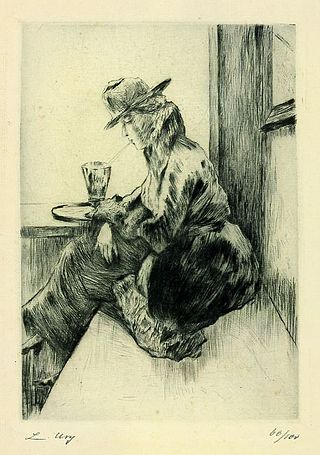
Drypoint is a printmaking technique of the intaglio family, in which an image is incised into a plate with a hard-pointed "needle" of sharp metal or diamond point. In principle, the method is practically identical to engraving. The difference is in the use of tools, and that the raised ridge along the furrow is not scraped or filed away as in engraving. Traditionally the plate was copper, but now acetate, zinc, or plexiglas are also commonly used. Like etching, drypoint is easier to master than engraving for an artist trained in drawing because the technique of using the needle is closer to using a pencil than the engraver's burin.

Willem van de Velde the Younger was a Dutch marine painter, the son of Willem van de Velde the Elder, who also specialised in maritime art. His brother, Adriaen van de Velde, was a landscape painter.

Militia Company of District II under the Command of Captain Frans Banninck Cocq, also known as The Shooting Company of Frans Banning Cocq and Willem van Ruytenburch, but commonly referred to as The Night Watch, is a 1642 painting by Rembrandt van Rijn. It is in the collection of the Amsterdam Museum but is prominently displayed in the Rijksmuseum as the best-known painting in its collection. The Night Watch is one of the most famous Dutch Golden Age paintings.

Hendrick Goltzius, or Hendrik, was a German-born Dutch printmaker, draftsman, and painter. He was the leading Dutch engraver of the early Baroque period, or Northern Mannerism, lauded for his sophisticated technique, technical mastership and "exuberance" of his compositions. According to A. Hyatt Mayor, Goltzius "was the last professional engraver who drew with the authority of a good painter and the last who invented many pictures for others to copy". In the middle of his life he also began to produce paintings.

Abraham Bloemaert was a Dutch painter and printmaker who used etching and engraving. He initially worked in the style of the "Haarlem Mannerists", but by the beginning of the 17th-century altered his style in line with the new Baroque style that was then developing. He mostly painted history subjects and some landscapes. He was an important teacher, who trained most of the Utrecht Caravaggisti.

The Hague School is a group of artists who lived and worked in The Hague between 1860 and 1890. Their work was heavily influenced by the realist painters of the French Barbizon school. The painters of the Hague school generally made use of relatively somber colors, which is why the Hague School is sometimes called the Gray School.

Rembrandt Harmenszoon van Rijn, usually simply known as Rembrandt, was a Dutch Golden Age painter, printmaker, and draughtsman. An innovative and prolific master in three media, he is generally considered one of the greatest visual artists in the history of art. It is estimated Rembrandt produced a total of about three hundred paintings, three hundred etchings, and two thousand drawings.

Aert de Gelder was a Dutch painter. He was the only Dutch artist to paint in the tradition of Rembrandt's late style into the 18th century.

Jacob Adriaensz Backer was a Dutch Golden Age painter. He produced about 140 paintings in twenty years, including portraits, religious subjects, and mythological paintings. In his style, he was influenced by Wybrand de Geest, Rubens and Abraham Bloemaert. He is also noted for his drawings of male and female nudes.
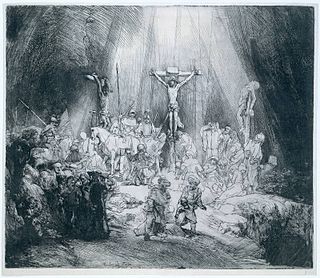
An old master print is a work of art produced by a printing process within the Western tradition. The term remains current in the art trade, and there is no easy alternative in English to distinguish the works of "fine art" produced in printmaking from the vast range of decorative, utilitarian and popular prints that grew rapidly alongside the artistic print from the 15th century onwards. Fifteenth-century prints are sufficiently rare that they are classed as old master prints even if they are of crude or merely workmanlike artistic quality. A date of about 1830 is usually taken as marking the end of the period whose prints are covered by this term.

Taco Dibbits is an art historian from Amsterdam, Netherlands and director of the Rijksmuseum Amsterdam.

Jan Verkolje or Johannes Verkolje was a Dutch painter, draughtsman and engraver. He is mainly known for his portraits and genre pieces of elegant couples in interiors and, to a lesser extent, for his religious and mythological compositions. He was a gifted mezzotint artist. Trained in Amsterdam, Verkolje spent his active professional career in Delft where he had access to powerful patrons.

Charles Howard Hodges, was a British painter active in the Netherlands during the French occupation of the 18th and early 19th century.
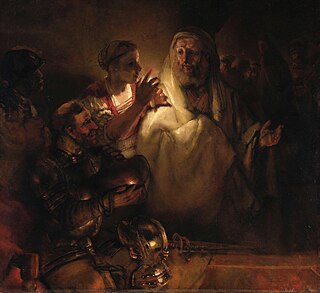
The Denial of Peter is a 1660 painting by Rembrandt, now in the Rijksmuseum in Amsterdam. It depicts the denial of Peter, an event in the Passion of Jesus.
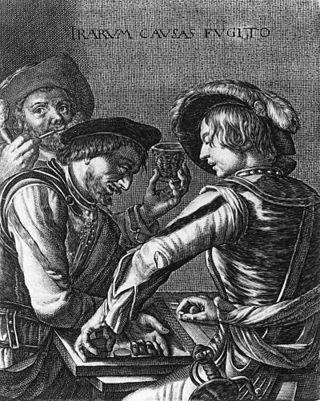
Crispijn (van) de Passe, also known as Crispijn (van) de Passe the Younger or Crispijn (van) de Passe (II), was a Dutch Golden Age engraver, draughtsman and publisher of prints. He was a member of the large printmaking Van de Passe family, son of the engraver and print publisher Crispijn van de Passe the Elder.
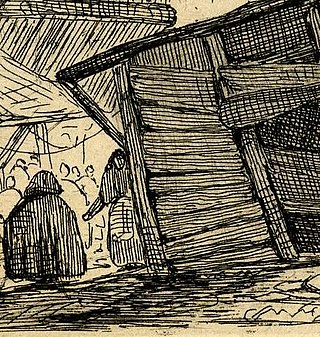
In printmaking, surface tone, or surface-tone, is produced by deliberately or accidentally not wiping all the ink off the surface of the printing plate, so that parts of the image have a light tone from the film of ink left. Tone in printmaking meaning areas of continuous colour, as opposed to the linear marks made by an engraved or drawn line. The technique can be used with all the intaglio printmaking techniques, of which the most important are engraving, etching, drypoint, mezzotint and aquatint. It requires individual attention on the press before each impression is printed, and is mostly used by artists who print their own plates, such as Rembrandt, "the first master of this art", who made great use of it.

Tobit and Anna with the Kid, also titled Tobit Accusing Anna of Stealing the Kid, and Tobit Praying for Death, is an early oil painting by the Dutch Golden Age painter Rembrandt, signed and dated 1626. It is now in the Rijksmuseum in Amsterdam.